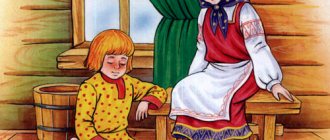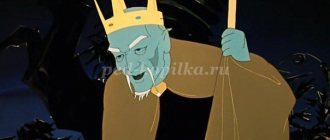Summary of a lesson on speech development in the senior group. Reading works of fiction
Topic: Reading works of fiction. “If you love to ride, you also love to carry a sleigh” (based on the works of E. Moshkovskaya “Lezhebok”, N. Nosov “On the Hill”).
Goal : to teach children to feel and understand the nature of the images of works of art, to assimilate the sequence of plot development, to notice expressive and visual means that help reveal the content; teach children to understand the figurative meaning of some phrases and sentences.
Progress of the lesson
The teacher reads E. Moshkovskaya’s poem “Lezheboka” to the children.
- Sloth lives bitterly:
- The couch potato's bed is high,
- The floors are far from the bed,
- Getting off the Sloth is a hassle!
- Here lies Lazyboka,
- Slothless sleeps without a deadline,
I’ve already laid down both sides...
He sleeps and sighs deeply:
- If only there were two more sides!..
- Guys, do you feel sorry for Sloth? (Children's answers).
- What can you advise Slothboy so that his life would not be so bitter and difficult? (Children's answers).
- Guys, do you want your friend to be Slacker? Why? (Children's answers).
- It turns out that no one wants to be friends with Sloth. No wonder they say: “He who is lazy is not valued.”
— Guys, would you like to make friends with Kotka Chizhov from N. Nosov’s story “On the Hill” ?
The guys worked all day: they built a snow slide in the yard. They shoveled snow and dumped it in a heap under the wall of the barn. Only by lunchtime the slide was ready. The guys poured water on her and ran home for dinner.
“Let’s have lunch,” they said, “while the slide freezes.” And after lunch we will come with a sled and go for a ride.
And Kotka Chizhov from apartment six, how cunning! He didn't build the slide. He sits at home and looks out the window as others work.
The guys shout at him to go build the slide, but he just throws up his hands outside the window and shakes his head - as if he’s not allowed to. And when the guys left, he quickly got dressed, put on his skates and ran out into the yard.
Chirk! - skating in the snow. - Chirk! And he doesn’t know how to skate properly. I drove up to the hill.
“Oh,” he says, “it turned out to be a good slide.” I'll jump now.
As soon as I climbed the hill, I hit my nose!
“Wow,” he says, “slippery!”
I got to my feet and again - bang! He fell ten times, but he can’t climb the hill. "What to do?" - thinks. I thought and thought and came up with the idea: “Now I’ll sprinkle sand on it and climb on it.”
He grabbed the plywood and drove to the janitor's room. There's a box of sand. He began to drag sand from the box up the hill. He sprinkles in front of himself, and he climbs higher and higher. I climbed to the very top.
“Now,” he says, “I’ll jump!”
He pushed off with his foot and again - bang with his nose! Skates don't skate on sand! Kotka lies on his stomach and says:
- How can we ride on the sand now?
And he climbed down on all fours.
Then the guys came running. They see: the hill is covered with sand.
- Who messed it up here? - they shouted. - Who sprinkled sand on the hill? Have you seen it, Kotka?
“No,” says Kotka, “I didn’t see it.” I sprinkled it myself because it was slippery and I couldn’t climb on it.
-Oh, you smart guy! Look what you came up with! We worked and worked, and he sand! How to ride now?
- Kotka says:
- “Maybe someday it will snow, it will cover the sand, and then you can ride.”
- “So it might snow in a week, but we need to go skiing today!”
- “Well, I don’t know,” says Kotka.
- Do not you know! You know how to ruin a slide, but you don’t know how to fix it! Grab a shovel now!
- Kotka untied his skates and took a shovel.
- - Cover the sand with snow!
- Kotka began to cover the hill with snow, and the guys poured water on it again.
- “Now,” they say, “it will freeze, and you can ride.”
- And Kotka liked the work so much that he also made steps on the side with a shovel.
“This,” he says, “makes it easy for everyone to climb.” Otherwise someone else will sprinkle sand again.
-Who is the story about? (About the guys, about Kotka Chizhov.)
— What words can you say about the guys who built the slide? What are they? (Friendly, hardworking.)
- What was Kotka Chizhov like at the beginning of the story? (Lazy, cunning, stupid.)
— What was he doing when the guys were building the slide? (He looked out the window, spread his arms, shook his head - as if he couldn’t, he was lazy, didn’t want to work with the guys...)
Alina Olegovna Sinitsyna, teacher at the Children's Educational Institution Child Development Center – “Kindergarten No. 3 “Morozko”, Severodvinsk, Arkhangelsk region. This summary has been compiled for children of senior preschool age who are receiving education according to the approximate educational program of the preschool “Childhood”. Can be used in a compensatory group for children with ODD.Summary of the educational activity for the perception of fiction in the senior group of compensatory orientation for children with special needs: “Reading the tale of P.P. Bazhov "Silver Hoof"
Program content:
Correctional educational tasks:
- introduce the meaning of the word skaz;
- teach to understand a literary text, its content, by encouraging them to answer questions about P. Bazhov’s work “The Silver Hoof.”
Correction and development tasks:
- develop children’s attention and auditory memory while listening to an audio recording - the tale “The Silver Hoof”;
- develop imagination through imagining the image of the main character of the tale, his dialogue with the cat, etc.
Correctional and educational:
— cultivate interest in reading works of Russian culture.
Vocabulary: tale
Techniques: organizational moment, listening to an audio recording - the tale “The Silver Hoof”, dynamic pause, conversation on the work, summing up.
Preliminary work: watching the cartoon “Silver Hoof”.
Progress:
Children enter the group to an excerpt from Valentina Tolkunova’s song “Fairy tales walk around the world” (slide 1)
Educator: Guys, do you like fairy tales?
Children: Yes
Educator: What tales about animals do you remember?
Children: “Teremok”, “Kolobok”, “Wolf and Seven Little Goats”, “Winter Hut of Animals”, etc.
Educator: Well done, you know a lot of fairy tales!
Today you will hear a tale in which one of the main characters is a forest goat.
Do you think a fairy tale and a fairy tale are different things?
Children: Various
Educator: “Tale” is a word very similar to the word “fairy tale”. Indeed, a fairy tale is an entertaining story in which fantastic events or heroes meet real ones. In these tales, the characters are ordinary people, and next to them are fairy-tale heroes.
Today I want to introduce you to a writer who was very fond of oral folk art and called his literary works skaz. Please look at the portrait. It depicts the writer Pavel Petrovich Bazhov (slide 2)
Educator: Today we will get acquainted with the tale “The Silver Hoof”.
Listen carefully
Listening to the audio recording of the tale “Silver Hoof” (slide 2)
Educator: Let's dream up. Close your eyes, imagine a beautiful animal, which in the fairy tale was called Silver Hoof.
Now let's try to depict the Silver Hoof. Get up from your seats. To make it easier for you to do this, I will say what a forest goat does, and you will try to portray it. Stand in a circle, one behind the other, and listen carefully.
(Dynamic pause “Silver hoof”)
Here is a handsome forest goat running through the forest, he raises his legs high. Then the goat stops and begins to kick the ground, either sparks or precious stones fly out from under his hoof. (Children run in a circle, stop and kick)
But then the trees rustled. Silver Hoof listened and ran away. (Children run in circles again)
As soon as I say “danger,” you must freeze in place or sit down and hide. (Children freeze)
Well done, take a seat on your chairs.
Educator: Now I will find out whether you listened carefully to the story. Remember and repeat the name.
Children: Silver hoof.
Educator: What characters did you meet in the tale? (Slide 3)
Children: Orphan Darenka, cat Murenka, grandfather Kokovanya, kid Silver Hoof.
(when you click on the slide again, a scattering of stones sounds)
Educator: How does the author describe the girl?
(Children's answers)
Educator: Look at how different artists depict the girl. (Slide 4)
Listen to how the author describes it
“On the little stove, by the stove, a girl is sitting, and next to her is a cat. The girl is small and the cat is small..."
“So Kokovan took the orphan to live with him. He’s big and bearded, but she’s tiny and has a button nose.”
Listen to another excerpt
“... the cat is small and so thin and tattered that it’s rare that anyone would let one into the hut. The girl is petting this cat..."
What kind of person do you think Darenka was, since she decided to take in such a skinny, tattered cat?
Children: Kind
“Only after every fairy tale will Daryonka remind you:
- Dedo, tell me about the goat. What is he like?
The girl asked a lot of questions about the goat, so what else can you say about her? What is she like?
Children: Curious
(when you click on the slide again, a scattering of stones sounds)
Educator: (gymnastics for the eyes) Let's try to portray how surprised the girl was when she saw the Silver Hoof for the first time.
Open your eyes wide. The girl couldn't believe her eyes. Close your eyes. Blink. That's how surprised I was.
Educator: Now will you tell me who Kokovanya is and how you imagine him? How can you describe him, what he is like?
(Children's answers)
Educator: Look at how different artists depict grandfather. (Slide 6)
Listen to how the author describes it
“There lived an old man alone in our factory, nicknamed Kokovanya”
“So Kokovan took the orphan to live with him. He’s big and bearded, but she’s tiny and has a button nose.”
What did Kokovanya usually do, what kind of work, who can remember?
Children: Grandfather was a hunter
Educator: Listen to an excerpt from the text.
“Who are you? - asks the girl.
“I,” he says, “are kind of a hunter.” In the summer I wash the sands, mine gold, and in the winter I run through the forests after a goat ... "
The girl immediately agreed to go and live with Kokovana. Why do you guys think. How did he seem to Daryonka?
Children: Kind, cheerful
Educator: The author writes. “The girl became curious about the goat. And then he sees that the old man is cheerful and affectionate.”
(when you click on the slide again, a scattering of stones sounds)
(Gymnastics for the eyes) Now imagine that you and I are hunters and are looking out for a goat from behind the bushes. Look right, left, up and down with your eyes.
Educator: What did Kokovanya tell Darenka about the goat called the silver hoof?
(Children's answers)
Educator: Look at the picture, it will help you describe the goat. (Slide
(Slide
“That goat is special. He has a silver hoof on his right front leg. Wherever he stamps this hoof, an expensive stone will appear.
Once he stomps - one stone, twice he stomps - two stones, and where he starts to hit with his foot - there is a pile of expensive stones.”
(when you click on the slide again, a scattering of stones sounds)
(gymnastics for the eyes) What bright stones fell down. Close your eyes. Open it up.
Educator: Guys, remember what a tale is?
(Children's answers)
Educator: A tale is an entertaining story in which fantastic events or heroes meet real ones.
What did you hear that was fabulous and unusual in the work, and what was real?
Children: There are no such goats in life, cats don’t speak, they just meow.
Educator: Let's dream a little more. (Slide 10)
What did Murenka and Silver Hoof talk about?
What did she tell the goat?
Where did Murenka and Silver Hoof disappear to?
(Children's answers)
Educator: Well done guys (when you press the slide again, a scattering of stones sounds). But what is this sound we constantly heard?
Or maybe it was the forest goat Silver Hoof who dropped by to see us? It seems to me that the sound was behind the door, sit, I’ll look, it’s suddenly dangerous!
Look, there is a bag of magic stones behind the door! Where did he come from here? (Slide 12)
Did you like the story? Why?
Who wrote the tale The Silver Hoof?
This concludes our lesson, but I have prepared one more surprise for the guys. Now we are going to decorate the house where the heroes of our tale lived with precious stones.
Guys, go to the sand table. I will draw you a house whose roof you will decorate.
References:
Scenarios of educational situations for introducing preschoolers to children's literature (from 5 to 6 years old) / author: O.M. Eltsova, A.V. Prokopyeva. – SPb.: PUBLISHING HOUSE “CHILDHOOD-PRESS” LLC, 2021, -160 p.
Presentation:


